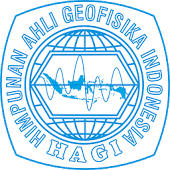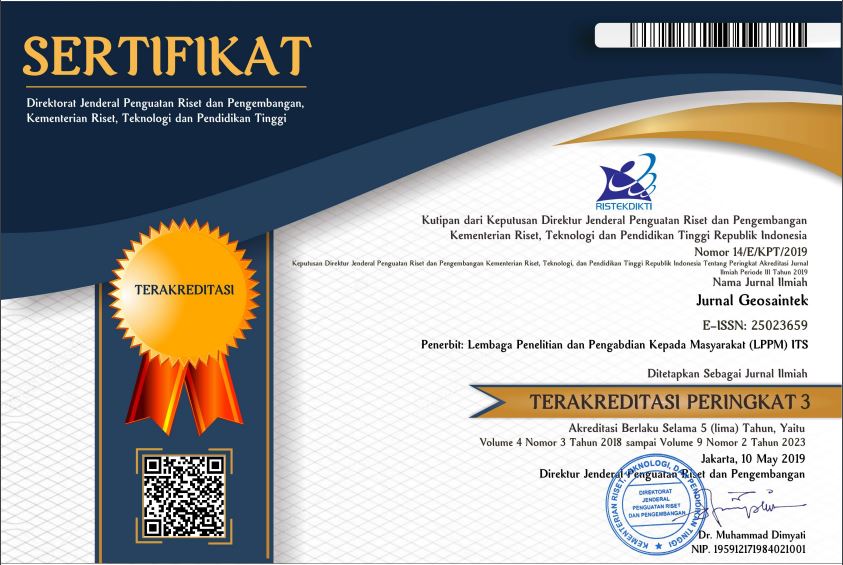PEMODELAN DISTRIBUSI AIR PANAS MENGGUNAKAN PROGRAM INVERSI DAMPED LEAST SQUARE PADA DATA VERTICAL ELECTRICAL SOUNDING DI DESA WAY MULI DAN KUNJIR
Abstract
The Mount Rajabasa area has several manifestations of hot springs that developed, one of which was in Way Muli and Kunjir Villages. The hot springs distributed layer in the area can be identified using the geoelectric resistivity vertical electrical sounding method. There were 3 sounding points of measurement results which were modelled in inversion using damped least squares. The purpose of this study was to determine the results of damped least square inversion modeling, determine subsurface lithology and model hot springs distribution by correlating 3 sounding points into 2-D transverse modelling. The results of data processing and modelling, there were 3 lithologies, namely top soil (14-466 m), sandstone (5-50 m) and clay (<5 m). The layer distributed by the hot springs was the sandstone layer. The results of the analysis of the hot springs well sample data show that the hot spring in the study area had a neutral pH, was brackish water and was a thermal spring.
Keywords
Damped Least Square; Hot Springs; Resistivity
Full Text:
PDFReferences
Chabaane, A., Redhaounia, B., Gabtni, H. (2017), “Combined Application of Vertical Electrical Sounding and 2D Electrical Resistivity Imaging for Geothermal Groundwater Characterization: Hammam Sayala Hot Spring Case Study (NW Tunisia)”, Journal of African Earth Sciences, Vol.134, hal. 292-298.
Edwin, T., Regia, R. A., dan Dibba, F. (2016), “Indikasi Intrusi Air Laut Dari Konduktivitas Air Tanah Dangkal Di Kecamatan Padang Utara”, Seminar Nasional Sains Dan Teknologi Lingkungan II.
Ekinci, Y. L., dan Demirci, A. (2008), “A Damped Least-Square Inversion Program for the Interpretation of Schlumberger Sounding Curves”, Journal of Applied Sciences 8 (22), 4070-4078.
Fauziyah, S., Khumaedi, dan Linuwih, S. (2015), “Interpretasi Struktur Bawah Permukaan Daerah Mata Air Panas Krakal Kebumen Dengan Metode Geolistrik”, Unnes Physics Journal, 4(2).
Goff, F., dan Janik, C. J. (2000), Geothermal Systems dalam Encyclopedia of Volcanoes, San Diego: Academic Press.
Grandis, H. (2009), Pemodelan Inversi Geofisika, Jakarta: Himpunan Ahli Geofisika Indonesia (HAGI).
Haerudin, N., Pardede, V. J., dan Rasimeng, S. (2009), “Analisis Reservoar Daerah Potensi Panas bumi Gunung Rajabasa Kalianda dengan Metode Tahanan Jenis dan Geotermometer Geothermal Reservoir Analysis of Mount Rajabasa Kalianda Potency Area using Resistivity Method and Geothermometer”, In Jurnal Ilmu Dasar, 10(2).
Koefoed, O. (1979), Geophysical Principal, Elsevier Scientific Publishing Company.
Kusnadi, D., Rezky, Y., Supeno, Raharja, B., (2006), “Penyelidikan Geologi dan Geokimia Panas Bumi Daerah Gunung Endut Kabupaten Lebak, Banten”, Proceeding Pemaparan Hasil-Hasil Kegiatan Lapangan Dan Non Lapangan Tahun 2006, Pusat Sumber Daya Geologi, pp. 1–14.
Mangga, S.A., Amiruddin, Suwarti, T., Gafoer, S., Sidarto, (1993), Geologi Lembar Tanjung Karang, Sumatera.
Mnzava, L. J., Mayo, A. W., dan Katima, J. H. Y. (2004), “In Search Of Geothermal Energy Power Potential In Tanzania: The Role Of Geophysics”, Geo-Environment, 358.
Panitia Ad Hoc Intrusi Air Asin Jakarta (PAHIAA-Jakarta). (1986), Klasifikasi Keasinan Perairan, Jakarta.
Pinehas, D., dan Warsa. (2019), “Determination of Groundwater Surface using Damped Least-Squares Inversion in the Bekasap Field Riau”, Jurnal Geofisika, No.2, pp. 5-8.
Reynolds, J. M. (1997), An Introduction to Applied and Environmental Geophysics, Chichester: John Wiley dan Sons Ltd.
Rizka, Fadhilah, R., Piskora, B. A., Putraloka, A., Alansyah, A., dan David, K. H. P. (2021)1, “The Identification of Krakatoa Tsunami Deposits Based on Comparison of Geological and Electrical Resistivity Tomography Method, in Kunjir, South Lampung”, IOP Conference Series: Earth and Environmental Science 830, 830(1).
Rizka, Fadhilah, R., Piskora, B. A., Putraloka, A., Alansyah, A., Hamonongan, K., David, P., dan Wulandari, R. (2021)2, “Integrasi Metode Geosains Untuk Mengidentifikasi Potensi Geowisata di Pantai Wartawan”, Bulletin of Scientific Contribution: Geology, 19, 187–196.
Sarkowi, M., dan Wibowo, R. C. (2021). “Geothermal Reservoir Identification based on Gravity Data Analysis in Rajabasa Area- Lampung”, Indonesian Journal of Geology and Mining, 31(2), 77.
Subtavewung, P. H., Raksaskulwong, M., dan Tulyatid, J. (2005), “The Characteristic and Classification of Hot Springs in Thailand”, Proceedings World Geothermal Congress.
Umam, M. F., Muhammad, F., Adityatama, D. W., dan Purba, D. P. (2018), “Tantangan Pengembangan Energi Panas Bumi Dalam Perannya Terhadap Ketahanan Energi di Indonesia”, Swara Patra, Vol.8, No.3.
DOI: http://dx.doi.org/10.12962%2Fj25023659.v8i3.13987
Refbacks
- There are currently no refbacks.

Jurnal Geosaintek diterbitkan oleh ITS bekerja sama dengan Himpunan Ahli Geofisika Indonesia (HAGI)
Disebarluaskan di bawah Lisensi Creative Commons Atribusi-BerbagiSerupa 4.0 Internasional.
Berdasarkan ciptaan pada https://iptek.its.ac.id/index.php/geosaintek/index.





